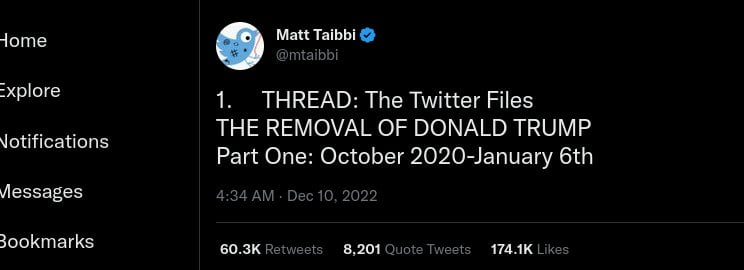Matt Taibbi: https://twitter.com/mtaibbi
1. THREAD: The Twitter Files
THE REMOVAL OF DONALD TRUMP
Part One: October 2020-January 6th— Matt Taibbi (@mtaibbi) December 9, 2022
2. The world knows much of the story of what happened between riots at the Capitol on January 6th, and the removal of President Donald Trump from Twitter on January 8th…
— Matt Taibbi (@mtaibbi) December 9, 2022
3. We’ll show you what hasn’t been revealed: the erosion of standards within the company in months before J6, decisions by high-ranking executives to violate their own policies, and more, against the backdrop of ongoing, documented interaction with federal agencies.
— Matt Taibbi (@mtaibbi) December 9, 2022
4. This first installment covers the period before the election through January 6th. Tomorrow, @Shellenbergermd will detail the chaos inside Twitter on January 7th. On Sunday, @BariWeiss will reveal the secret internal communications from the key date of January 8th.
— Matt Taibbi (@mtaibbi) December 9, 2022
5. Whatever your opinion on the decision to remove Trump that day, the internal communications at Twitter between January 6th-January 8th have clear historical import. Even Twitter’s employees understood in the moment it was a landmark moment in the annals of speech. pic.twitter.com/tQ01n58XFc
— Matt Taibbi (@mtaibbi) December 9, 2022
6. As soon as they finished banning Trump, Twitter execs started processing new power. They prepared to ban future presidents and White Houses – perhaps even Joe Biden. The “new administration,” says one exec, “will not be suspended by Twitter unless absolutely necessary.” pic.twitter.com/lr66YgDlGy
— Matt Taibbi (@mtaibbi) December 9, 2022
7. Twitter executives removed Trump in part over what one executive called the “context surrounding”: actions by Trump and supporters “over the course of the election and frankly last 4+ years.” In the end, they looked at a broad picture. But that approach can cut both ways. pic.twitter.com/Trgvq5jmhS
— Matt Taibbi (@mtaibbi) December 9, 2022
8. The bulk of the internal debate leading to Trump’s ban took place in those three January days. However, the intellectual framework was laid in the months preceding the Capitol riots.
— Matt Taibbi (@mtaibbi) December 9, 2022
9. Before J6, Twitter was a unique mix of automated, rules-based enforcement, and more subjective moderation by senior executives. As @BariWeiss reported, the firm had a vast array of tools for manipulating visibility, most all of which were thrown at Trump (and others) pre-J6.
— Matt Taibbi (@mtaibbi) December 9, 2022
10. As the election approached, senior executives – perhaps under pressure from federal agencies, with whom they met more as time progressed – increasingly struggled with rules, and began to speak of “vios” as pretexts to do what they’d likely have done anyway.
— Matt Taibbi (@mtaibbi) December 9, 2022
11. After J6, internal Slacks show Twitter executives getting a kick out of intensified relationships with federal agencies. Here’s Trust and Safety head Yoel Roth, lamenting a lack of “generic enough” calendar descriptions to concealing his “very interesting” meeting partners. pic.twitter.com/kgC4eGykcO
— Matt Taibbi (@mtaibbi) December 9, 2022
12. These initial reports are based on searches for docs linked to prominent executives, whose names are already public. They include Roth, former trust and policy chief Vijaya Gadde, and recently plank-walked Deputy General Counsel (and former top FBI lawyer) Jim Baker.
— Matt Taibbi (@mtaibbi) December 9, 2022
13. One particular slack channel offers an unique window into the evolving thinking of top officials in late 2020 and early 2021.
— Matt Taibbi (@mtaibbi) December 9, 2022
14. On October 8th, 2020, executives opened a channel called “us2020_xfn_enforcement.” Through J6, this would be home for discussions about election-related removals, especially ones that involved “high-profile” accounts (often called “VITs” or “Very Important Tweeters”). pic.twitter.com/xH29h4cYt9
— Matt Taibbi (@mtaibbi) December 9, 2022
15. There was at least some tension between Safety Operations – a larger department whose staffers used a more rules-based process for addressing issues like porn, scams, and threats – and a smaller, more powerful cadre of senior policy execs like Roth and Gadde.
— Matt Taibbi (@mtaibbi) December 9, 2022
16. The latter group were a high-speed Supreme Court of moderation, issuing content rulings on the fly, often in minutes and based on guesses, gut calls, even Google searches, even in cases involving the President. pic.twitter.com/5ihsPCVo62
— Matt Taibbi (@mtaibbi) December 9, 2022
17. During this time, executives were also clearly liaising with federal enforcement and intelligence agencies about moderation of election-related content. While we’re still at the start of reviewing the #TwitterFiles, we’re finding out more about these interactions every day.
— Matt Taibbi (@mtaibbi) December 9, 2022
18. Policy Director Nick Pickles is asked if they should say Twitter detects “misinfo” through “ML, human review, and **partnerships with outside experts?*” The employee asks, “I know that’s been a slippery process… not sure if you want our public explanation to hang on that.” pic.twitter.com/JEICGRTyz7
— Matt Taibbi (@mtaibbi) December 9, 2022
19. Pickles quickly asks if they could “just say “partnerships.” After a pause, he says, “e.g. not sure we’d describe the FBI/DHS as experts.” pic.twitter.com/d3EaYJb5eR
— Matt Taibbi (@mtaibbi) December 9, 2022
20. This post about the Hunter Biden laptop situation shows that Roth not only met weekly with the FBI and DHS, but with the Office of the Director of National Intelligence (DNI): pic.twitter.com/s5IiUjQqIY
— Matt Taibbi (@mtaibbi) December 9, 2022
21. Roth’s report to FBI/DHS/DNI is almost farcical in its self-flagellating tone:
“We blocked the NYP story, then unblocked it (but said the opposite)… comms is angry, reporters think we’re idiots… in short, FML” (fuck my life). pic.twitter.com/sTaWglhaJt— Matt Taibbi (@mtaibbi) December 9, 2022
Note: There may have been a typo in the sequence numbering, which after 21 skips to 23.
23. Some of Roth’s later Slacks indicate his weekly confabs with federal law enforcement involved separate meetings. Here, he ghosts the FBI and DHS, respectively, to go first to an “Aspen Institute thing,” then take a call with Apple. pic.twitter.com/i771hD8aCD
— Matt Taibbi (@mtaibbi) December 9, 2022
24. Here, the FBI sends reports about a pair of tweets, the second of which involves a former Tippecanoe County, Indiana Councilor and Republican named @JohnBasham claiming “Between 2% and 25% of Ballots by Mail are Being Rejected for Errors.” pic.twitter.com/KtigHOiEwF
— Matt Taibbi (@mtaibbi) December 10, 2022
The FBI’s second report concerned this tweet by @JohnBasham: pic.twitter.com/8J8j5GlUVx
— Matt Taibbi (@mtaibbi) December 10, 2022
25. The FBI-flagged tweet then got circulated in the enforcement Slack. Twitter cited Politifact to say the first story was “proven to be false,” then noted the second was already deemed “no vio on numerous occasions.” pic.twitter.com/LyyZ1opWAh
— Matt Taibbi (@mtaibbi) December 10, 2022
26. The group then decides to apply a “Learn how voting is safe and secure” label because one commenter says, “it’s totally normal to have a 2% error rate.” Roth then gives the final go-ahead to the process initiated by the FBI: pic.twitter.com/lyZm4gmT19
— Matt Taibbi (@mtaibbi) December 10, 2022
27. Examining the entire election enforcement Slack, we didn’t see one reference to moderation requests from the Trump campaign, the Trump White House, or Republicans generally. We looked. They may exist: we were told they do. However, they were absent here.
— Matt Taibbi (@mtaibbi) December 10, 2022

